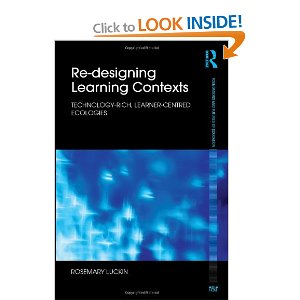 A little while ago I spoke to Emma Cook from the Guardian about children using iPads. I note that her report in today’s Family section draws a connection to the case of the 4 year old who was reported to be receiving treatment for screen addiction. It is certainly worth taking a moment to reflect on how we use family technology and in particular the increasingly ubiquitous iPad/phone. I have no doubt that the most important thing about this technology within a family is that children and parents can share the activities being completed in a way that was just too cumbersome with previous desktops and laptops. Wonderful learning experiences are possible through the conversations that happen around the activities children are iPadding. This is in stark contrast to the image of the individual child seemingly mesmerized by their technology and ignoring what is happening around them. As ever with technology, it is how we use it that matters most.
A little while ago I spoke to Emma Cook from the Guardian about children using iPads. I note that her report in today’s Family section draws a connection to the case of the 4 year old who was reported to be receiving treatment for screen addiction. It is certainly worth taking a moment to reflect on how we use family technology and in particular the increasingly ubiquitous iPad/phone. I have no doubt that the most important thing about this technology within a family is that children and parents can share the activities being completed in a way that was just too cumbersome with previous desktops and laptops. Wonderful learning experiences are possible through the conversations that happen around the activities children are iPadding. This is in stark contrast to the image of the individual child seemingly mesmerized by their technology and ignoring what is happening around them. As ever with technology, it is how we use it that matters most.
In a recent report we noted some of the striking issues about iPads, learning and education.
When it comes to Teaching and Learning students are generally reported to be positive about the iPads, seeing them as essential for 21st century education. Within this report there are examples of iPads being used to support learners beyond simple drill and practice games, to support collaborative learning, to provide personalised learning experiences, iPads to augment and enhance deep learning, as ubiquitous, distributed and connected learning tools. We also discuss the ways in which iPads can contribute to Digitally-Enhanced Monitoring and Assessment.
- iPads can support seamless learning, allowing learners to easily switch learning contexts – from formal to informal or personal to social – and to take control of their own learning. For example, to supplement what they are learning in class in real-time through additional web-based inquiry, or by making digital notes.
- The finger-driven iPad interface can motivate and engage students, keeping them interested in content for longer, and allowing groups to interact with the device at the same time and with the same object. This enhances and stimulates simultaneous opportunities for face-to-face social interaction in ways that desktop, laptop and even netbook computing with their mouse-driven screen, ‘individual’ peripherals, fixed location, weight and overall design do not.
- Research suggests that the adoption and use of iPads in and beyond the classroom allows students to augment and enhance their learning in ways that were previously not possible or not so easy to do.
- Teachers, students and parents report that the multiple communication features, routine availability and easy accessibility of iPads in the classroom and in students’ homes make communication between teachers and students, and school and home easier and more routine.
- A key potential benefit of iPad-like devices involves their working in combination with other technologies. In combination with efficient network connectivity and cloud storage they offer ever-increasing capacity for the collection and collation of data about learning activity wherever learners are. The analysis and representation of this data about learning is vital to formative evaluation, assessment, self-assessment and reflection.
The evidence from parents is positive in the main. They identify benefits such as: increased engagement and interest in learning, gains in knowledge and technology skills, more time spent on homework and more opportunity to make learning relevant and authentic. Parents state that home-school communication is improved with the introduction of 1:1 tablet devices and that not having heavy school bags to carry around is a major benefit. Parents do also express some anxiety about breakage, theft, loss or misuse of the devices by children, and express concern about costs and inconsistencies in what parents are expected to contribute.
For learners iPads are easy to use and attractive. The research on iPad use and adoption overwhelmingly reports that tablet devices have a positive impact on students’ engagement with learning. Findings report increased motivation, enthusiasm, interest, engagement, independence and self-regulation, creativity and improved productivity.
For teachers, there is evidence that iPads enhanced the learning experience and transformed teaching practice. Mobility, portability and general ease of use as well as rapid one-touch access to tools (compared with time consuming logins and resource-booking requirements for networked computers) enabled a wider range of learning activities to routinely occur in the classroom. The availability of a wide range of apps and connectivity to cloud computing as well as the immediacy of communication (via email, facetime, etc.) with students afforded by the omni-present iPads enabled teachers to explore alternative activities (3D, interactive, multimodal, virtual tours, etc.) and forms of assessment. In addition, teachers felt that the devices enabled them, as teachers, to promote independent learning, to differentiate learning more easily for different student needs and to easily share resources both with students and with each other. There are however some implications for training and development and we identify that there are recognisable phases in teacher familiarisation with these devices and their integration into classroom activity. The identification of these phases can inform CPD.
For decision makers, such as school leaders, there is pressure to enhance learning and iPads offer potential to help. Many schools have adopted the iPad or similar ‘Post-PC’ tablet devices, whilst many others are looking to do so in the near future. We can learn from their experiences. Our research revealed multiple drivers and implementation models for iPads in schools and classrooms. The majority of 1:1 implementation models were driven by government bodies and school leaders. Small-scale approaches, such as class sets, and shared group iPads, tended to originate from other groups: industry pilots, researcher-supported studies, individual teachers or digital champions and individual schools. Primary schools were more likely to go for shared devices and class sets, whereas secondary schools tended to aim for 1:1 devices. Early adopters tended to fund devices whereas more recent adopters are more likely to seek funding through parental contributions or to arrange leasing options for students.
Our review suggests that schools wishing to use tablets should have a clear rationale for adopting this technology. Successful implementation of tablet technologies in schools requires careful, long-term planning before, during and after the event. Such planning involves consideration of existing technical networks, ownership models, the technology lifecycle, broad stakeholder preparation and on-going engagement (parents, teachers, learners, technical managers, etc.) as well as plans for capturing progress and evaluation.
In the current UK climate, funding in schools is very tight and many feel that the high cost of rolling out 1:1 tablet initiatives requires strong justification. The potential impact of initial and follow-on costs on what is an already limited funding stream is a particularly controversial issue for some, especially in those instances where parents are being asked to ‘take up the slack’. A variety of ownership models were identified. It is important to recognise that the range and variety of ownership models do, however, have implications for organising students’ learning, continuity of access to students’ work and learning data, as well as to management, maintenance and security of the devices.
There are also significant implications for other user groups. The technical support implications are significant. The apparent ease of transition that many of the UK schools that have successfully implemented an iPad initiative exhibited was masked due to the fact that they had recently moved to new, well-equipped school buildings. Beyond the provision of the network, the integration process can be made worse if new devices like tablets are not provided by the school or college and belong to learners, are of different makes and types and use different operating systems. The consistency of the iPad operating system and interface and the availability of apps, as well as issues of security, backup, restore and lifecycle support was identified as an important benefit of iPads over other devices. However, other device manufacturers have upped their game and can now compete in this important area. In this respect, the rapid pace of development in the area of tablet computing is a key issue for schools as they plan for future technology needs and one that requires a process of continuous evaluation.
No technology has an impact on learning in its own right; rather, its impact depends upon how it is used. iPads are no exception to this and in this report we identify ways in which iPads can be used to support teaching and learning. There is evidence that they can help teachers, learners and parents in multiple ways to be more effective. To leverage these learning benefits, the iPad should play the supporting role to the learning activity. The question that should be asked is not ‘Can iPads support learning?”, but rather “how can iPads be used to support collaborative learning, or exploratory learning”, or whatever. The iPad it is one of a range of tools that can help learning, and when used wisely it can be effective. For schools, teachers and parents thinking of investing in iPads, there is much to be learnt from those who have already taken this path, and an increasing array of devices and ownership options to choose from. As with all technology, this is not a ‘one-off’ decision and the on-going costs, and the need for on-going evaluation and monitoring should not be underestimated.












